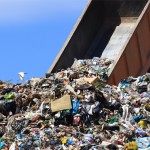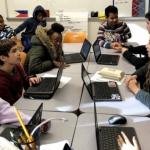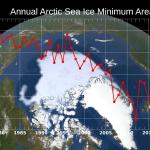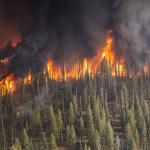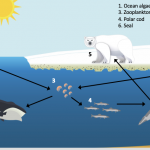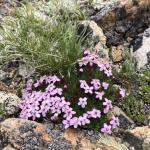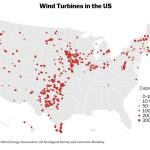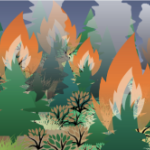Lesson Plans & Activities
Design a Resilient Future
This is a lesson that can be used to get ideas and prepare for the Community Resilience Expo.
In this lesson, students will work in small groups to develop an idea to increase community resilience, utilizing Design Thinking.
How Can We Decrease Our Impact on the Earth’s Climate at our School?
This is the first lesson in the Climate Resiliency Education Design Challenge Unit which was designed to follow the middle or high school Climate Resiliency Education units.
In this design challenge lesson students explore the Denver Public School District’s solid waste plan and discuss how their school can save or decrease emissions by reducing solid waste at our school.
How Does Our School Food System Create Greenhouse Gas Emissions?
This is the second lesson in the Climate Resiliency Education Design Challenge Unit which is meant to follow the middle or high school Climate Resiliency Education units.
In this design challenge lesson, students examine their school food system and develop an investigation about food waste in order to know what should change.
How Can We Understand Waste and Emissions in Our School's Food System?
This is the third lesson in the Climate Resiliency Education Design Challenge Unit which is meant to follow the middle or high school Climate Resiliency Education units.
This lesson outlines for students how to design and carry out an investigation to audit their school’s food waste system.
How Can We Reduce Emissions Associated with Food Waste in Our School?
This is the fourth lesson in the Climate Resiliency Education Design Challenge Unit which is meant to follow the middle or high school Climate Resiliency Education units.
In this activity students utilize the data that is collected and propose solutions to mitigate food waste in their school.
How Can We Present Solutions for Food Waste and Emissions at School?
This is the fifth lesson in the Climate Resiliency Education Design Challenge Unit which is meant to follow the middle or high school Climate Resiliency Education units.
This lesson provides guidance for students to create and practice a presentation about their design challenge results that they developed in the previous lessons and how to present it to the school administration.
Wildfire Virtual Expo
This lesson provides a virtual alternative to the HEART Force Expo curriculum.
This is a streamlined lesson for students to prepare for a Community Resilience Expo, focusing on wildfire.

Flood Virtual Expo
This lesson provides a virtual alternative to the HEART Force Expo curriculum.
This is a streamlined lesson for students to prepare for a Community Resilience Expo, focusing on flood.

Drought Virtual Expo
This lesson provides a virtual alternative to the HEART Force Expo curriculum.
This is a streamlined lesson for students to prepare for a Community Resilience Expo, focusing on drought.
Data Puzzle: On a Budget
This data puzzle is a stand-alone lesson that is part of a larger collection of data puzzles.
The Arctic is currently warming at a rate faster than the global average, a phenomenon known as Arctic amplification. In this Data Puzzle, students analyze authentic Arctic datasets to construct explanatory models for the following question, "Why might the Arctic be warming faster than other places on Earth?"
Data Puzzle: Balancing Act
This data puzzle is a stand-alone lesson that is part of a larger collection of data puzzles.
Since the early 2000s, the Greenland Ice Sheet’s mass balance has been consistently negative, meaning more mass is being lost than gained. But this change in mass balance hasn’t always happened at the same rate. What could account for observed changes to the amount of ice in the Greenland Ice Sheet in recent decades?
Data Puzzle: To Reflect or Not to Reflect
This data puzzle is a stand-alone lesson that is part of a larger collection of data puzzles.
The color of Earth's surface determines how much of the Sun's energy is reflected or absorbed, where lighter-colored surfaces are more reflective (higher albedo). In this Data Puzzle, students analyze authentic Arctic data to construct explanatory models for the following question, "How might the Arctic’s albedo be affected by the observed decline in sea ice?"
Data Puzzle: It's All Connected
This data puzzle is a stand-alone lesson that is part of a larger collection of data puzzles.
What makes the Arctic climate system so unique is the sea ice, which influences the Arctic climate in many ways. In this Data Puzzle, students analyze authentic Arctic data to construct explanatory models for the following question, "What effect, if any, do leads (cracks in the sea ice) have on the transfer of moisture between the Arctic Ocean and atmosphere?"
Data Puzzle: Megafire - Rare Occurrences or the New Normal?
This data puzzle is a stand-alone lesson that is part of a larger collection of data puzzles.
Megafires have been a hot topic in the news over the past few years, but are they a new phenomenon? In this Data Puzzle, students analyze authentic wildfire data to construct explanatory models for the follow question, "How and why has the number of megafires have changed over time?"
Data Puzzle: Megadrought in the Colorado River Basin
This data puzzle is a stand-alone lesson that is part of a larger collection of data puzzles.
Much of the western United States is experiencing drought conditions. In this Data Puzzle, students analyze authentic climate data to construct explanatory models for the following question, "What is causing the megadrought in the Colorado River Basin?"
Data Puzzle: What's the Limit?
This data puzzle is a stand-alone lesson that is part of a larger collection of data puzzles.
Moss campion is a hearty flowering plant that thrives in harsh arctic and alpine tundra ecosystems over a wide range of latitudes in North America. In this Data Puzzle, students analyze authentic moss campion growth and survival data to construct explanatory models for the following question, "How is the growth and survival of moss campion affected by latitude?"
Data Puzzle: Tracing Carbon Through the Arctic Food Web
This data puzzle is a stand-alone lesson that is part of a larger collection of data puzzles.
The Arctic is home to a huge variety of living things (humans included) that have adapted to harsh conditions. However, these conditions are changing as Arctic temperatures rise and sea ice declines. In this Data Puzzle, students trace the flow of carbon through the Arctic food web to construct explanatory models for the following question, "How might the decline in sea ice affect Arctic organisms large and small?"

Data Puzzle: The Tipping Point
This data puzzle is a stand-alone lesson that is part of a larger collection of data puzzles.
Plants like moss campion are uniquely adapted to the cold, dry climate characteristic of the tundra biome...but temperatures are on the rise. In this Data Puzzle, students analyze temperature and reproduction data to construct explanatory models for the following question "How is moss campion reproduction affected by temperature?"
Data Puzzle: Wind Farms of the Future
This data puzzle is a stand-alone lesson that is part of a larger collection of data puzzles.
Transitioning from fossil fuels to clean, renewable energy sources like wind is essential if the US is to reduce its carbon emissions. But where should new wind farms be constructed? In this Data Puzzle, students analyze surface roughness and wind speed data to construct an evidence-based explanation for the following question, "Where in the United States (lands and waters) should new wind turbines be constructed to generate the most energy?"
Data Puzzle: Wildfire, Drought, and the Future of Forests
This data puzzle is a stand-alone lesson that is part of a larger collection of data puzzles.
Wildfires are burning more and more of the forests across the western United States. In this Data Puzzle, Data Puzzle, students analyze post-fire forest recovery datasets as they gather evidence to construct explanatory models for the following question, "How do climate conditions impact the recovery of forests after a wildfire?"

